This is because the chief problem with the Killing Joke isn't that Barbara Gordon is attacked and paralysed. The chief problem is that she is attacked, paralysed and then promptly ignored by the story. We see little of how Barbara feels about what has happened to her and the attack is purely motivated as a way to affect male characters (in this case James Gordon and Batman). This is something that is very important to remember when discussing this type of story (dubbed women in refrigerators by Gail Simone). The attack on Barbara kick starts the events of the Killing Joke but this story is not about Barbara. The story is about Batman and the Joker, Barbara is used as little more than collateral damage by the story.
But how does this tie in with how someone would go about adapting the Killing Joke? Simple. If you want to flesh out the Killing Joke you need to transform it from a story in which Barbara is paralysed into a story about Barbara being paralysed.
You might be wondering how I would suggest that could be done. Firstly more attention needs to be put on how Barbara reacts to the news that she will no longer be able to walk. A proper scene in which the character was given the news and began to process it would go a long way towards making Barbara more involved in what should be her story, and it would provide a quieter scene in between the assault and Batman's visit to the amusement park.
The second thing that the adaptation would need is to have Barbara involved in taking down the Joker in some capacity. Now I will admit that this could be tricky to pull off. The whole point of anything the Joker does is that he wants Batman to know that he did it. In the Killing Joke he also wants Batman to know exactly where to find him. Batman doesn't discover the Joke in the Killing Joke, he is invited. The writers would also have to consider the fact that Barbara would be physically and emotionally devastated by the attack and also be undergoing pretty heavy duty medical care.
The way to get around this would be to have the confrontation between the Batman and the Joker take place as the middle of the story rather than the end and to expand the scale of the Joker's plan. Doing so would enable Barbara to recover somewhat to the point from which she could affect the story and expanding the Joker's plan would give her something to thwart without changing the original intent behind the story.
In the Killing Joke the Joker sets out to prove that anyone can be driven mad by one bad day and plans to use James Gordon as an example. One route that the adaptation could go down would be to have Jim Gordon be the first example rather than the only example. The movie could depict this as something that the Joker intended all along or as a plan B for him to fall back on.Either way it would be resolved by Barbara figuring out that there was more to the Joker's plan and using the skills that she would go on to employ as Oracle and to point Batman in the right direction.
Finally we need to see what will come next for Barbara. When Barbara Gordon was originally payalysed in the Killing Joke there was no plan for the character. If it hadn't been for the efforts of writers Kim Yale and Jim Ostrander the character would have been discarded. Since the Killing Joke many stories have dived into how the experience shaped Barbara and how she grew into the role of Oracle. The best way for the adaptation to end would not be with Batman and the Joker laughing on the roof (as great as that ending is) but with Barbara vowing to apply herself in a new direction rather than give up on the fight against evil. If they did that then it would truly become her story.






